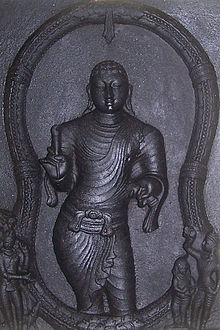Ilango Adigal

Ilango Adigal (
Biography
Iḷaṅkō Aṭikaḷ (lit. "the venerable ascetic prince"), also spelled Ilango Adigal or Ilangovadigal, is traditionally believed to be the author of the Cilappatikaram. No direct verifiable information is available about him.
The author was a Jaina scholar, as in several parts of the epic, the key characters of the epic meet a Jaina monk or nun.[9][12] The last canto of the epic, lines 155-178, mentions "I also went in", whose "I" scholars have assumed to be the author Adigal.[9] The epic also mentions, among other details, the "Gajabahu synchronism".
These verses state Adikal attended the animal sacrifice by king Senguttuvan in the presence of Gajabahu, someone believed to have been the king of Ceylon (Sri Lanka) between 171 and 193 CE.[13] This has led to the proposals that Adikal lived in the same period. These lines also mention that he became a sannyasi in a monastery outside Vanci – the capital of the 2nd-century Chera kingdom (now parts of Kerala). This declaration has been interpreted as renouncing and becoming a Jain monk.[9]
According to Kamil Zvelebil, all this must have been a fraudulent statement added by Ilango Adikal to remain a part of the collective memory in the epic he wrote.[14] Adikal was likely a Jain who lived a few centuries later, states Zvelebil, and his epic "cannot have been composed before the 5th- or 6th-century".[13]
Gananath Obeyesekere – a scholar of Buddhism, Sri Lankan religious history and anthropology, considers the epic's claims of Gajabahu and the kinship between Ilango Adigal and Senguttuvan to be ahistorical, and that these lines are likely "a late interpolation" into the Tamil epic.[9][11] The author was likely not a prince, nor had anything to do with the Chera dynasty, says R Parthasarathy, and these lines may have been added to the epic to give the text a high pedigree status, gain royal support, and to "institutionalize the worship of goddess Pattini and her temples" in the Tamil regions (modern Kerala and Tamil Nadu) as is described in the epic.[9]
According to another Tamil legend, an astrologer predicted that he would become the ruler of the land. To stop this, and let his elder brother be the king, the prince became a Jain monk taking the name of Ilango Adigal.[citation needed]
Legacy
The Cilappatikaram epic credited to Ilango Adigal inspired another Chera-Tamil poetic epic called
See also
References
- ^ "Who Was Ilango Adigal? – Amar Chitra Katha". www.amarchitrakatha.com. 18 June 2020. Retrieved 13 September 2020.
- ISBN 978-81-317-0336-6.
- ISBN 978-81-260-1221-3.
- ^ JSTOR 3250226.
- ^ Adigal 1965, p. VIII.
- ^ ISBN 978-0-14-303196-3.
- ^ Gananath Obeyesekere (1970). "Gajabahu and the Gajabahu Synchronism". The Ceylon Journal of the Humanities. 1. University of Sri Lanka: 44.
- ^ Kamil Zvelebil 1973, pp. 174–176.
- ^ a b c d e f g R Parthasarathy (Translator) 2004, pp. 6–7.
- ^ Kamil Zvelebil 1973, pp. 52–53.
- ^ a b Gananath Obeyesekere (1970). "Gajabahu and the Gajabahu Synchronism". The Ceylon Journal of the Humanities. 1. University of Sri Lanka: 42–45.
- ^ Kamil Zvelebil 1973, pp. 172–181.
- ^ a b Kamil Zvelebil 1973, pp. 174–177.
- ^ Kamil Zvelebil 1973, p. 179.
Bibliography
- V R Ramachandra Dikshitar (1939), The Silappadikaram, Oxford University Press
- Adigal, Prince Ilangô (1965), Shilappadikaram: (The Ankle Bracelet), translated by ISBN 9780811200011
- R Parthasarathy (Translator) (2004). The Cilappatikāram: The Tale of an Anklet (Iḷaṅkōvaṭikaḷ). Penguin Books. )
- Kamil Zvelebil (1973). The Smile of Murugan: On Tamil Literature of South India. BRILL. ISBN 90-04-03591-5.
External links
- Works by Ilango Adigal at LibriVox (public domain audiobooks)

